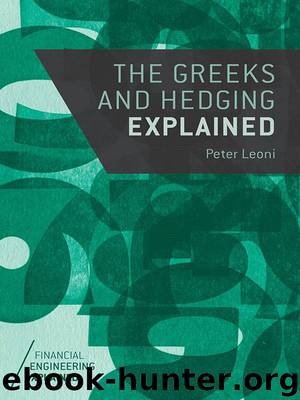The Greeks and Hedging Explained (Financial Engineering Explained) by Peter Leoni

Author:Peter Leoni [Leoni, Peter]
Language: eng
Format: mobi, epub
ISBN: 9781137350756
Publisher: Palgrave Macmillan
Published: 2014-05-28T23:00:00+00:00
4
Trading Is the Answer to the Unknown
4.1 Uncertainty and Confusion
In the first part of this book, we focused on the hedging argument of a plain vanilla option. Within the Black–Scholes model, we explained that hedging away the risk can be done quite accurately up to finite-size effect. In real life there are many difficulties [35, 133] that prevent us from believing this model is a perfect representation of the world. However, as we will see later on, these flaws in the model do not take away the valuable lessons we can learn from it [79]. Moreover as it turns out, a solid understanding of the same basic flaws in the model allow a good trader to anticipate and take position in a smart way.
In this chapter we will learn by means of a simple example how trading volatility [118, 119] will work. Before we can start talking about trading, we need to introduce uncertainty and dynamics into the picture. If something is known completely deterministically, there is not much trading around it; it is purely a hedging story where the cost of hedging is the premium charged. We saw several examples of this. If a client wanted to buy a certain stock at a future point in time, the price he had to pay for it was completely fixed. However, as we already explained in Chapter 1, the introduction of uncertainty in the form of dividends could alter the picture and lead to a discussion about the price. We showed that the cost of hedging itself became uncertain. There was still a good hedging strategy available, but the risk could not be eliminated completely. In the literature, this kind of situation is described by saying the marked is incomplete [133, 16].
The first models within the quantitative finance community were always complete, such as the binomial tree model [40] or Black–Scholes [18, 113]. Leaving room for interpretation or uncertainty in the parameters could seem like a flaw of the model. However, from the determination of the forward price, it should become clear to the reader that the world is uncertain and a lot of parameters that enter into a model are random, and it is therefore normal that each trader might have her own expectation. This leads to price competition and, if the market is transparent enough and enough players are available to provide the liquidity, the market finds a consensus or equilibrium on this.
Let us now turn to the particular case of the valuation problem of a plain vanilla call option. We wrote down the Black–Scholes pricing formula in (1.10) as if this solved the whole problem. We explained that the price was related and in fact a direct consequence of the cost of the hedging strategy, and we analysed in more detail how errors are introduced because the hedging is not done continuously. Before we move on, we would like to wipe out some more certainties the reader might have. After all, the more uncertainty there is, the more it becomes possible to challenge one’s own beliefs versus the beliefs of others.
Download
The Greeks and Hedging Explained (Financial Engineering Explained) by Peter Leoni.epub
This site does not store any files on its server. We only index and link to content provided by other sites. Please contact the content providers to delete copyright contents if any and email us, we'll remove relevant links or contents immediately.
The Black Swan by Nassim Nicholas Taleb(6763)
Bad Blood by John Carreyrou(6274)
Pioneering Portfolio Management by David F. Swensen(6078)
Millionaire: The Philanderer, Gambler, and Duelist Who Invented Modern Finance by Janet Gleeson(4094)
Skin in the Game by Nassim Nicholas Taleb(3965)
The Money Culture by Michael Lewis(3846)
Bullshit Jobs by David Graeber(3829)
Skin in the Game: Hidden Asymmetries in Daily Life by Nassim Nicholas Taleb(3722)
The Wisdom of Finance by Mihir Desai(3523)
Blockchain Basics by Daniel Drescher(3329)
Liar's Poker by Michael Lewis(3221)
The Intelligent Investor by Benjamin Graham Jason Zweig(2930)
Hands-On Machine Learning for Algorithmic Trading by Stefan Jansen(2925)
Mastering Bitcoin: Programming the Open Blockchain by Andreas M. Antonopoulos(2891)
Fooled by Randomness: The Hidden Role of Chance in Life and in the Markets by Nassim Nicholas Taleb(2860)
Investing For Dummies by Eric Tyson(2793)
The Power of Broke by Daymond John(2773)
Market Wizards by Jack D. Schwager(2538)
Zero Hour by Harry S. Dent Jr. & Andrew Pancholi(2533)
